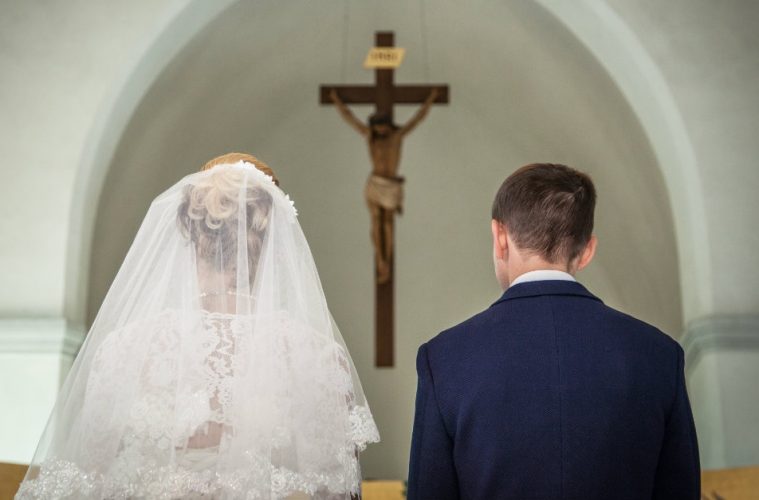I began my Catholic schooling in second grade and was part of the parochial school system until I graduated from Dowling Catholic High School in 2015. Most of school was just as normal as you would find in other public ones – except for the weekly school mass, the chapel where you prayed to God to help you out on the test you forgot to study for next period, the school having an official priest, and the religion classes.
While there were electives for other religions, all the mandatory ones focused on an aspect of Catholicism. Somehow the subject of marriage seemed to come up in all of them, and there was only one Truth about that subject: Marriage was a sacrament between one man and one woman. No student arguments, class protests, or walkouts would change the answer the Catholic religion had held as part of the One Truth for two thousand years.
The “one man and one woman” answer and line most people have heard comes from the first book of the Bible, Genesis 2:24. However, having been removed from Catholic schooling for a few years, but utilizing the curious nature they instilled in me, I decided to revisit that statement and investigate further. It turns out the Bible defines marriage in seven other ways. According to Dr. Robert Cargill, an assistant professor of Classics and Religious Studies at the University of Iowa, the Bible defines marriage as the following as well:
- Man and brother’s widow (Genesis 38: 6-10)
- Man and wives and concubines (Solomon had over 300 concubines)
- Rapist and his victim (Deuteronomy 22: 28-29)
- Man and woman and women’s property (i.e. slaves) (Genesis 16)
- Male solider and prisoner of war (Numbers 31: 1-18; Deuteronomy 21: 11-14)
- Man and woman and woman and woman (i.e. polygamy) (Solomon had over 700 wives)
- Male slave and female slave (Exodus 21: 4)
It appears the nature of marriage is more than only between one man and one woman. Additionally, Christianity has not been kind to divorcees, and in Catholicism they are not allowed to eat the Eucharist, an important sacrament in that denomination; furthermore, most Christian denominations do not recognize a divorce as valid in the eyes of God. However, Christianity has helped marriage just as much as they have hurt it. As Rodney Stark notes in his book, The Rise of Christianity, obligations began being placed on the husbands, saying, “Christians condemned promiscuity in men as well as in women and stressed the obligations of husbands toward wives as well as those of wives toward husbands…. The symmetry of the relationship Paul described was at total variance, not only with pagan culture, but with Jewish culture as well.”
Also, consent played a much more important role than it had before. In 1140, the Benedictine monk Gratian published his book Decretum Gratiani, which became canon law and stated that consent of the couple matter more than their families’ approval.
Finally, prior to Christianity, marriage was used for strategic purposes, whether that was to improve the relationship between two nations or a way of signing an agreement between two feuding farming families. Over a thousand years, Christianity slowly integrated itself into many nation’s cultures and marriage turned from a strategic move to a sign of sacred love. By the 12th century, Catholic Church leaders were referring to marriage as a sacrament, and it later became one of the Seven Sacraments in 1563 at the Council of Trent.
In the present day, it seems many Christian denominations are divided on how to approach marriage. The Methodist faith, the second-largest Protestant denomination with 12 million members, faced this issue head-on in 2016 when Rev. Val Rosenquist married two male members of her congregation in Charlotte. The aftermath of that decision saw support from many and backlash from others, with Rev. Talbot Davis stating that support for anything other than traditional marriage would mean the Methodist denomination would be turning its back on the Bible. Additionally, Rev. James Howell noted the most important thing for Methodist to do was stay together, not split up.
Moreover, the Catholic Church has been led by Pope Francis since 2013, and he is seen by many as one of the most progressive leaders in Vatican City. In the year he took office as Pope, he was asked by journalist Andrea Tornielli how he viewed gay people and atheists; he responded, “Who am I to judge?” However, multiple times during his speech at the Humanum Conference in Rome in 2014, he defended the Church’s backing of traditional marriage.
Christianity and its numerous denominations should not be shamed for their beliefs or feel shame from the shifting tides of history. There is no religion without flaws, and each of their sacred texts must be read and understood within the context of the time in which it was written. That being said, it is important for every religion and any organization to review its beliefs and stances from time to time and decide whether certain beliefs and crucially important to their values, or if some changes can be warmly welcomed and implemented.

